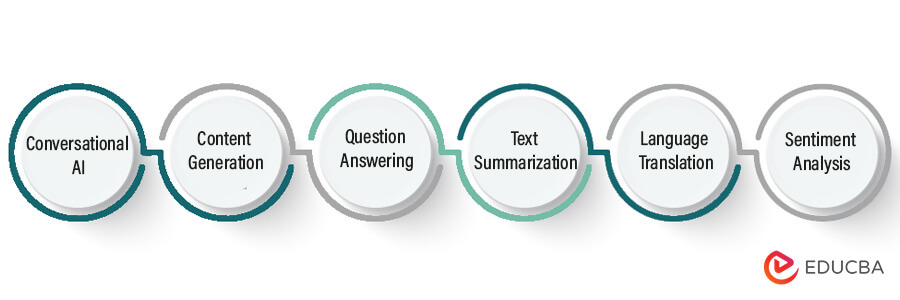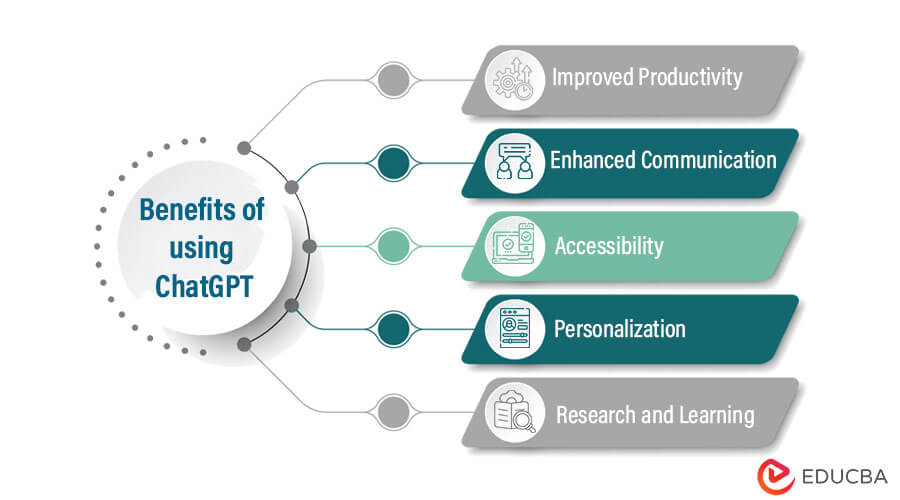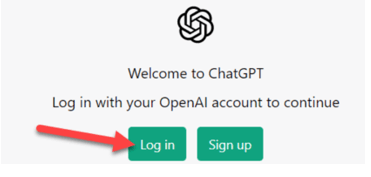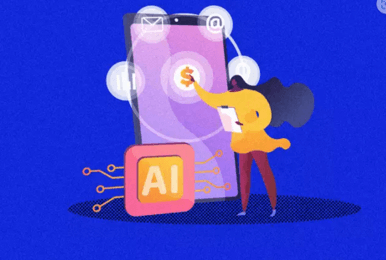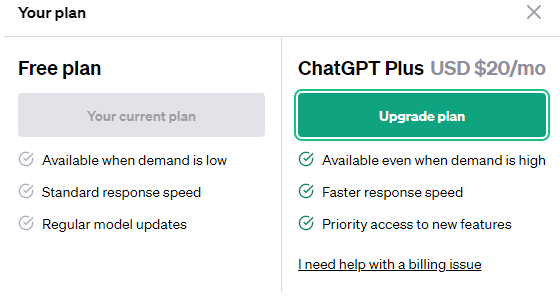Updated September 12, 2023
What is ChatGPT
ChatGPT, developed by OpenAI and based on the GPT-4 architecture, is an advanced language model designed to understand and generate text that closely mimics human language. This enables users to engage in seamless conversations, create content, and perform various natural language processing tasks. As a versatile tool, it has numerous applications, including chatbots, content generation, translation, and more, making it invaluable for diverse purposes.
What is a language model?
A language model is an AI algorithm that can understand, predict, and generate text based on context. It uses statistical probabilities to predict the most likely next word or phrase in a sequence, enabling it to create coherent sentences and paragraphs that resemble human-generated text. It depends on a vast language model trained to work on enormous amounts of data to produce natural language responses to different prompts and fed to virtual assistants and chatbots.
How was ChatGPT built?
ChatGPT is built on top of the GPT family of huge language models. It is fine-tuned by human feedback using human AI trainers to make the ChatGPT into a bot skilled in managing false assumptions, accepting mistakes, and answering sequel queries. Microsoft developed a supercomputer from thousands of Nvidia GPUs to train ChatGPT. It can produce human-like text that depends on the conversation or prompt to understand the context.
Features of ChatGPT
Some key features of ChatGPT include
- Conversational AI: ChatGPT can engage in human-like conversations on various topics.
- Content Generation: It can generate creative content, such as articles, stories, or marketing materials.
- Question Answering: ChatGPT can provide answers to factual questions or offer opinions on subjective topics.
- Text Summarization: It can condense lengthy texts into concise summaries.
- Language Translation: ChatGPT can translate text between multiple languages.
- Sentiment Analysis: It can determine the sentiment of a text, such as positive, negative, or neutral.
Benefits of using ChatGPT
Using ChatGPT offers several advantages:
- Improved Productivity: It can automate repetitive writing tasks, allowing users to focus on more creative aspects of their work.
- Enhanced Communication: It can help users express their ideas more effectively by providing suggestions or improving grammar and style.
- Accessibility: ChatGPT can be an assistive technology for people with disabilities, enabling them to communicate more efficiently.
- Personalization: It can tailor content to individual preferences, creating a more personalized user experience.
- Research and Learning: ChatGPT can be a valuable resource for students and researchers, providing information and insights on various topics.
How to use ChatGPT?
The user should get sign-in access to the ChatGPT, which can be done via cloud-based APIs delivered by modeling companies like OpenAI.
The input data to ChatGPT should be given in text format and can be a simple message.
The input data can be fed to the ChatGPT model via API given by the enterprise that created the model.
Once the data is fed, the ChatGPT processes it and gives the output as text, which can be used in another conversation model.
If the user continues to work on ChatGPT, he can fine-tune the responses and enhance the performance by modulating the parameters or input data.
1. Using ChatGPT for everyday tasks
It can complete everyday routines like the following:
- Drafting emails or messages: It can help you compose well-structured and concise emails or text messages.
- Fact-checking: Use ChatGPT to quickly find information or verify facts on various topics.
- Brainstorming ideas: It can help you generate creative ideas for projects, articles, or marketing campaigns.
- Learning new topics: Engage in a Q&A session with ChatGPT to deepen your understanding of various subjects.
- Language translation: It can assist with translating text between multiple languages.
2. Interacting with ChatGPT
Interacting with ChatGPT involves effectively communicating your queries or prompts to get the desired output. Here are some tips to make your interaction with ChatGPT more productive:
- Start with a clear prompt: Provide concise and specific input, making it easier for ChatGPT to understand your query. This will help the AI generate more accurate and relevant responses.
- Provide context: Supply relevant background information when necessary to help ChatGPT generate better responses. For example, if you’re asking for a summary of a specific article, provide a brief description or a link to the article for reference.
- Use step-by-step instructions: Break down complex tasks or queries into more straightforward, step-by-step instructions. This can help ChatGPT focus on each aspect of your request and provide more accurate results.
- Ask follow-up questions: If the initial response from ChatGPT is unclear or doesn’t fully address your query, ask follow-up questions to clarify or seek additional information. This can also help you explore the topic in greater depth.
- Experiment with prompts: If the response isn’t satisfactory, try rephrasing your input, using synonyms, or providing more context. Different phrasings can sometimes yield better results.
- Be patient and flexible: Give ChatGPT some time to process your input and generate a response. Be prepared for occasional inaccuracies or misunderstandings, and adjust your query as needed.
- Use system-level instructions: Guide the behavior of ChatGPT by providing high-level instructions, such as “Write a summary in a formal tone” or “Explain the concept in simple terms for a beginner.” This can help you obtain outputs tailored to your specific needs.
3. Customizing your ChatGPT experience
- Adjust parameters: Modify settings such as temperature and maximum tokens to control the randomness and length of the generated output.
- Use system-level instructions: Guide the behavior of ChatGPT by providing high-level instructions, such as “Write a summary in a formal tone.”
4. Best experiences for using ChatGPT
It gives exciting experiences to the user, who tends to use it effectively.
- It is used to produce enhanced ideas and brainstorm
- ChatGPT gives personalized recommendations according to the user’s requirement
- It can manage, understand and deliver complicated topics in a simple human-understanding format.
- Creating blogs, articles, essays, and snappy quotes is practical assistance for writing.
- It summarizes the latest research and gives different insights to the user to make him look at all possible perspectives.
- The output is of high quality and is utilized for coding and debugging.
- It helps to make multiple-choice questions.
- It can be the user’s travel partner and give him adaptable plans according to his package.
- By sensing human tone and emotions, it is capable of understanding feelings. It helps to compose a song with meaningful lyrics.
- The user can generate his dataset and customize the ChatGPT using his data which helps him to excel in his career.
ChatGPT for business
You can integrate ChatGPT into your business operations by incorporating it into your website or mobile app or using it to power a chatbot for customer service. Businesses can also use ChatGPT for internal processes, such as generating reports or analyzing customer feedback.
Using ChatGPT for customer service can provide several benefits, such as reducing response times, improving the accuracy of responses, and freeing up staff for other tasks. It can also offer 24/7 customer support, improving customer satisfaction and loyalty.
Industries such as healthcare, finance, e-commerce, and education can leverage ChatGPT for various applications, including medical diagnosis, financial advice, product recommendations, and research assistance.
Customizing ChatGPT to suit your specific business needs is possible. You can achieve this by training it on industry-specific data or fine-tuning its responses to suit particular use cases. You can customize it to match your brand voice or provide a personalized customer experience.
Applications of ChatGPT
Some potential applications are listed below:
- Customer service – ChatGPT can power chatbots and virtual assistants for customer service, providing 24/7 support and reducing response times.
- Content generation – It can generate content for social media or marketing campaigns, blog posts, and other forms of digital content.
- Language translation – It can translate text between different languages, improving communication across international borders.
- Education – ChatGPT can assist with homework and research, provide personalized tutoring, and even grade essays and assignments.
- Healthcare – It can assist with medical diagnosis, provide patients with health advice, and identify potential drug interactions.
- Finance – ChatGPT can provide financial advice, assist with investment decisions, and even analyze market trends.
ChatGPT’s capabilities and limitations
ChatGPT’s Capabilities
- ChatGPT can generate human-like language in response to prompts or questions.
- It can complete sentences or paragraphs, answer questions, translate text, summarize long passages, and more.
- It can be customized to match specific business needs or use cases.
- Various language-related tasks can be completed more quickly and effectively with its help.
- Businesses can use ChatGPT for various applications, such as customer service, content creation, language translation, research, and product recommendations.
Limitations
While ChatGPT is a Proficient resource, it has limitations. Some limitations include the following:
- It may generate inappropriate or biased responses, mainly if the training data comprises narrow or inappropriate content.
- ChatGPT may not always be able to offer accurate or relevant responses, especially when it comes to complex or nuanced questions.
- It may not accurately capture the intended tone or style of the prompt or question.
- It might face difficulties comprehending the context, especially for ambiguous or complex language.
Advanced:
1. Machine learning and artificial intelligence
Artificial intelligence and machine learning are huge topics that govern the world today. The subset of AI is machine learning which builds statistical models and algorithms to manage computers and make predictions on trained data to describe future events.
2. Natural language processing
NLP is the branch of artificial intelligence that merges rule-based design of the human language and computational linguistics to interpret deep learning models and statistical and machine learning methods. Combining all these algorithms, the computer can process human language in text form or voice information to understand the complete meaning of the author’s intent and emotions.
3. Deep learning
Deep learning is specifically a neural network with three or multiple layers to simulate the characteristics of the human brain that allows for learning enormous amounts of data. Whereas the neural network is a unit layer that makes appropriate predictions, added hidden layer can support refining and optimizing for accuracy values. Everyday services like self-driving cars, fraud detection, voice-enabled TV remotes, and digital assistants apply deep learning technology.
4. Computer vision
Computer vision is based on artificial intelligence, which allows the systems and computer to compute meaningful insights into digital videos, images, and other visual data to take decisive actions based on the inputs. In simple, if AI could think, then computer vision supports them to observe, see and interpret.
5. Reinforcement learning
Reinforcement learning is the optimal behavior of the environment to attain maximum reward. Here the data is collected from machine learning and uses the trial and error method where the data is not a section of the input found in unsupervised or supervised learning.
6. Explainable AI
Explainable Artificial Intelligence (XAI) is a set of methods and processes that enable users to understand and trust the output given by machine learning methods. You can use XAI to compute any model’s outcomes, accuracy, transparency, and fairness using decision-making techniques from powered AI.
News and Updates
The cyberspace administration of China is working on AI services to mitigate emerging technology risks.
Alibaba is yet to launch generative AI technology to roll out Tongyi in all applications.
New features and improvements
The enhancement features planned to imply are still in progress; they are working to make the model more reliable and trustworthy by providing an intuitive interface with millions of iterations. So it will be soon launched like a crystal ball which gives the client the exact thing they require
Community and user feedback
Community and user feedback are essential to the development of ChatGPT. OpenAI encourages users to provide feedback on their experience with ChatGPT, which can help to inform future updates and improvements. Additionally, Online communities like Reddit can offer insights into ChatGPT’s usage and its influence on different industries and use cases.
FAQs
Frequently asked questions about ChatGPT
Q1. Is ChatGPT free to use?
Answer: It is available as a free platform, and anyone can be accessed the website of OpenAI. You can subscribe to ChatGPT Plus for $20 per month.
Q2. Can I customize ChatGPT’s response?
Answer: You can customize it to give niche responses and produce output based on user-fed data without fine-tuning. It offers real-time responses and can recollect the conversation.
Q.3. Is ChatGPT secure and private?
Answer: OpenAI is serious about ensuring the user’s privacy. The policy gives clear definitions with laws and regulations about the collected user information and follows all the security measures to protect the data.
Q4. Can ChatGPT be integrated with other software or platforms?
Answer: You can incorporate ChatGPT with Bing, Slack, Opera, Skype, Snapchat, and Edge applications.
Troubleshooting common issues
Server issues, network errors, insufficient data, corrupted browser cookies, incorrect settings, outdated versions, software conflicts, and extension issues are common reasons why ChatGPT may not work. You can clear the cache and search history, update the software, and disable extensions to resolve these issues. If the issue persists, contact support from ChatGPT.
Getting help and support
In https://help.OpenAI.com/ and submit a message on the topic where assistance is required.
Conclusion
Hence, this is the overview of ChatGPT, which has all the essential insights and high functionality when implied in routine tasks. I hope the article serves all the vital details and understanding to all the users in different industries and they can tell it according to productive output.
Recommended Articles
We hope that this EDUCBA information on “ChatGPT” was beneficial to you. You can view EDUCBA’s recommended articles for more information,

